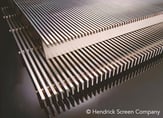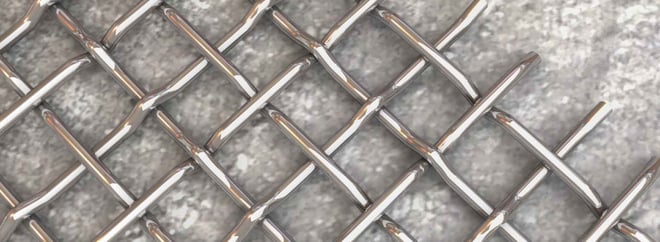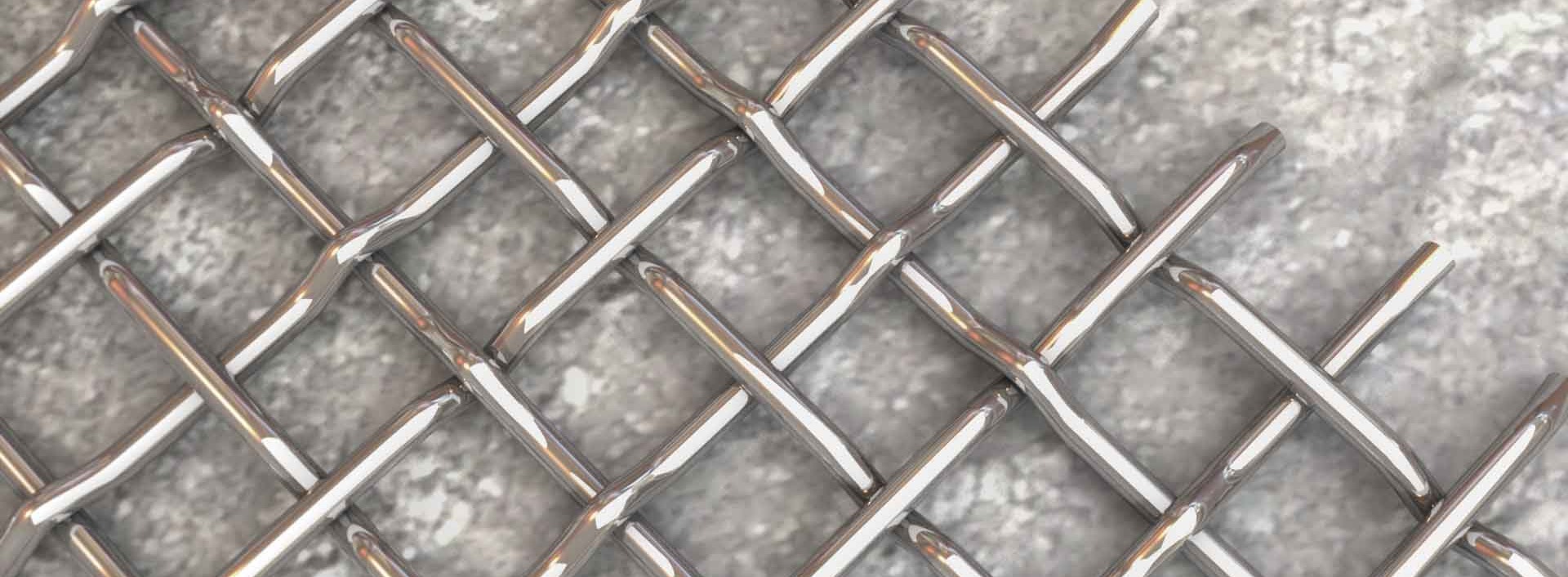Comparing Filter Media: Woven Wire Mesh vs Wedge Wire
In the world of filtration, there are endless types of materials you can use to achieve the desired result. All of these different materials can be formed or treated differently depending on your application or your specific filtration needs.
At W.S. Tyler, we specialize in woven wire mesh, however, we have encountered and gained a comprehensive understanding of other filtration media over the past 150 years. One of the most frequently asked questions is: “What is the difference between woven wire and wedge wire screens?”
These two metals can seem very similar to the naked eye but they are truly very different. Both have their pros and cons depending on what type of application you are using it for and what your needs are.
In this article, we are going to take a look at both woven wire and wedge wire as filter media. We will cover the advantages and disadvantages, comparing the two in the following categories:
- Durability
- Pore Size/Micron Rating
- Fabrication Options
- Cleanability
- Strength
- Weight
- Service Life
- Open Area/Flow/Pressure Drop
- Cost
What Is a Wedge Wire Filter Screen?
Wedge wire is a metallic filter media made up of v-shaped wires that are lined up against or wound around a supportive structure. They are then welded to bond them to the support structure.

The material being filtered will flow through slotted openings created by the wires. Most often, the surface facing the liquid is flat and smooth side while the v-shaped profile is on the bottom.
The support structure for this material is located opposite of the incoming material, which allows it to support the media while staying out of the path of flow. Flow direction can be either outside-to-inside or inside-to-outside and the filter is constructed accordingly.
Top Applications for Wedge Wire:
- Filtering foods that have a high level of purity
- Oil filtration
- Brewing industry filtration (microbreweries and bottled teas)
- Fertilizer industry
- Solids from wastewater
Wedge Wire Dimensions:
Wedge wire is most commonly formed into cylinders or panels. Typical cylinder sizes and slot opening/micron ranges include:
- Diameter: between 1” - 36”
- Length - Virtually any length is possible
- Micron Rating - As low as 30 micron or as large/open as necessary
Benefits of Wedge Wire:
- Resistance to clogging - The wide slot openings allow for less clogging due to fewer contact points while retaining an accurate opening size for efficient filtration.
- Precisely-sized slot openings - Specified open area or micron ratings are held with great accuracy due to the robust nature of the construction.
- Easy-to-clean surface - The smooth surface of the filter allows for easy and complete cleaning, whether through physical cake removal or by back-flushing
- low pressure drop - The wide but precise open area allows for good flow and an acceptable amount of pressure drop when these filters are part of a system.
- High strength - Wedge wire filter screens are a self-supporting structure and are inherently robust because of the cross-section of the wires, the sub-structure, and the fact that those items are welded together at many points throughout the fabrication.
- Service life - Wedge wire filter screens can be cleaned and reused indefinitely and the high-strength nature resists damage, leading to a filter media with a long service life.
What Is Woven Wire Mesh?
This type of filtration media can go by a few different names: Woven wire cloth, woven wire mesh, and woven wire fabric.

As its name implies, wire mesh is woven on a loom in a similar way to how cloth is woven. The wires are oriented in two directions: the warp direction and the schute direction.
Now, this material is typically manufactured into rolls and then either cut or formed into a desired shape and size.
The woven material creates a very stable but flexible filtration media that is almost like fabric or cloth. It can be made up of wires of different thicknesses or woven into different patterns depending upon the specified application.
But due to its labor-intensive production, woven wire mesh is generally used in more complex or technical applications.
Read the following article to gain a comprehensive understanding of what woven wire mesh is:
Typical Applications for Woven Wire Mesh:
- Sifting and sieving
- Architectural applications
- Pest control and livestock cages
- Ventilation screens
- Air and water filters
- Wastewater
- Filters for fuel, oil, and hydraulic systems
Benefits of Woven Wire Mesh:
- Customization: Because the media is woven, parameters such as opening size, specific weave type, and even the thickness of each wire can be customized. These changes will affect price and usage, but there are lots of ways to get the specific results you need.
-Ventilation: Woven wire mesh allows for steady, uninterrupted flow in a ventilation application. Air can be allowed to pass in and out of an area or it can be used to keep impurities out of the vessel that needs ventilation. It can also act as pre-filtration, which will provide good flow while helping the life of finer filtration that is located downstream.
- Precise openings/Accuracy: This material is woven on very precise high-speed looms and high-quality wires with tight dimensional tolerances are used. This leads to pore sizes that are very precise, accurate, and repeatable.
- Flexibility: The wires being woven but not welded together allows the material to be formed into various shapes and specifications without damaging the material or losing accuracy.
- Fabrication: This material is able to be cut, formed, or fabricated into nearly any shape imaginable by the use of typical sheet metal fabrication techniques. The end product can be small and simple or very large and very complex.
- Cleanable/Reusable: The nature of the material being metallic and offering surface filtration rather than depth filtration leads to a filter that is cleanable and reusable, making for a much longer service life than a typical disposable filter.
- Harsh Environments: Woven wire mesh offers fine filtration in environments that other fine filters simply cannot withstand. It can be produced in specifications that will perform well when a low micron rating is required in an application that involves high pressure, high temperature, or corrosive chemicals.
Wedge Wire vs. Woven Wire Mesh
Now that we have reviewed both materials on their own, we are going to compare each material in the following categories: Durability, Pore Size/Micron Rating, Fabrication Options, Cleanability, Strength, Weight, Service Area, Life span, Open Area/Flow/Pressure Drop, and Cost.
Durability
When it comes to durability, wedge wire is inherently more durable due to the fact that it is made up of heavier wire & components than the finer specifications of woven wire mesh.
However, while woven wire mesh itself may not be as durable, it can be made to be as strong as necessary through additional processes like laminating into multiple layers or by combining it with an additional support or protection structure.
In the bigger world of filtration, both wedge wire and woven wire mesh are go-to solutions when the filter is exposed to harsh environments.
Pore Size/Micron Rating
The pore size or micron rating of wedge wire typically goes down to about 30 micron (.030mm). Woven wire mesh can be fabricated to a micron rating of 5 micron.
If very fine metallic filtration that maintains acceptable flow is required, woven wire mesh will have the edge in this situation. The woven material allows for precise control over opening sizes, even when not visible to the naked eye.
That said, either material can be made with openings as large as necessary. Both types of media can be made with accurate openings, so both can provide very accurate filtration.
Fabrication Options
Wedge wire is typically formed into larger (in excess of 1” diameter x inches in length) cylinders, plates, or cones/funnels. In this regard, fabrication options are relatively limited.
Woven wire mesh can be more easily formed into many different kinds of shapes and configurations. This is what makes woven wire such a great material for filtration.
Typical sheet metal forming techniques are generally used for woven wire mesh, so the options are practically endless.
Woven wire mesh can also be combined with plastic over-molding, different filter media, and can be made into a wider variety of sizes - from very small (⅛” in diameter) to extremely large (the size of a small car).
To learn more about the capabilities of fabricated woven wire mesh, read the article below:
Cleanability
Both woven wire mesh and wedge wire are typically used for surface filtration, meaning that the filter cake, or buildup of material, being filtered from a liquid resides on the surface of the filter. This allows the filter to be easily cleaned and reused.
While both types of media are cleanable and reusable, wedge wire usually proves to be more easily cleaned due to a surface structure that is a bit smoother than woven wire mesh. There is also a bit less risk of damaging the material when cleaning wedge wire.
Gain insight into what it takes to clean a wire mesh filter by reading the following aricle:
Strength
When talking about strength, wedge wire is vastly stronger than woven wire mesh. The very nature of wedge wire promotes strength - the wires are thick & robust, the substructure is strong, and everything is resistance welded together.
However, if finer filtration or a smaller footprint is required, woven wire mesh fabrications can also be quite strong with the addition of value-added services like our Porostar® or a support structure. While wedge wire is inherently very strong, woven wire mesh can also operate in high-pressure environments if the correct steps are taken to ensure this type of durability.
Weight
The great strength of wedge wire comes at the cost of weight. The relatively thick & wide filtration wires located closely together along with the robust support structure result in a filter that is nearly all solid metal.
If your micron rating and pressure needs will allow for the use of woven wire mesh, your filter will weigh less overall. This could lead to a further reduction of system weight if less-robust components are necessary to support the filter media.
Life Span
Life span could refer to how long a filter can run between cleanings, how many times the filter can be cleaned, or how long the filter will last in the conditions in which it operates.
Wedge wire is typically more robust and can sometimes be cleaned easier, so these filters will typically have a longer service life.
The more delicate nature and finer wires within woven wire mesh could lead to a shorter service life when compared to wedge wire. Woven wire can still be cleaned and maintained but there is a higher risk of wear and tear.
Open Area/Flow/Pressure Drop
Open area or flow rates are always a concern with any filtration system. This critical characteristic becomes even more of a concern when strength requirements increase and micron ratings decrease.
There is a delicate balance between strength, flow, and micron rating that needs to be paid attention to. Expectations need to be realistic when deciding on a design where these characteristics are important.
Wedge wire has larger openings and will flow very well. That flow is going to slow down substantially when the wedge wire is constructed with lower micron ratings. Strength is maintained, but undue pressures result when attempts are made to maintain the desired flow rate.
This is where moving to woven wire mesh can be beneficial. Flow is maintained at lower micron ratings and strength can be added through lamination or support.
Learn more about pressure drop in the article below:
Cost
Metallic filter media is never a low-cost option, but it is used because of special requirements pertaining to micron rating, pressure, or harsh environments.
While wedge wire and woven wire mesh are both on the upper end of filter media costs, wedge wire will typically be a bit more expensive than woven wire mesh.
This is due to the volume of material involved, the slow speed of production, and the cost of the equipment involved to produce this type of filter.
Woven wire mesh has a wider variety of costs depending on what processes are involved, but a wedge wire fabrication will typically be more expensive than a comparable woven wire mesh fabrication.
Get a better idea of how much a woven wire mesh fabrication costs in the article below:
Select the Right Alloy to Design the Perfect Wire Mesh Filter
Even though woven wire mesh and wedge wire are similar in their nature and use, there are a lot of differences between the two. Woven wie mesh is typically used when the filtration of fine particles while maintaining adequate throughput is required whereas wedge wire is reserved for harsher applications that depend on robust filter components.
Now, this article established that a lot of thought must be put into the design of a woven wire mesh fabrication in order for its durability to be on par with a wedge wire fabrication. A big component of this is the alloy you use to weave your wire mesh.
W.S. Tyler has been supplying woven wire mesh filter fabrications for over 150 years and wants you to feel confident in the performance of your filter system.
Read the following article to gain a better idea of what woven wire mesh alloy will perform best when implemented into your process:



